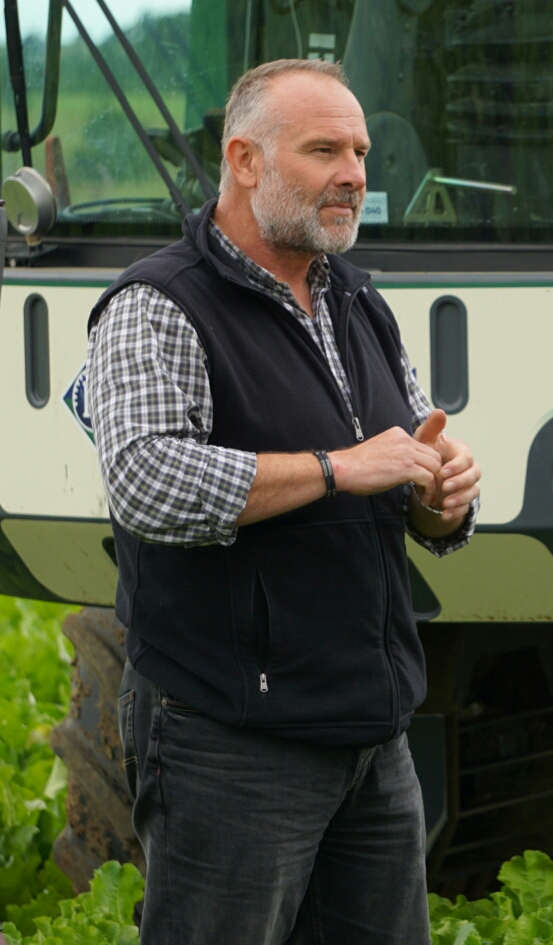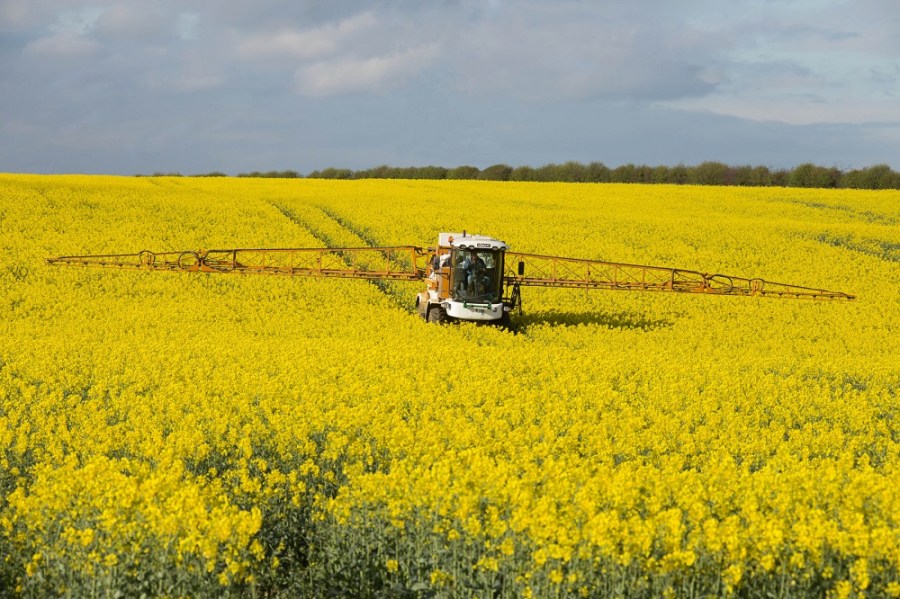The bell may be tolling for OSR but losing the crop from the rotation will impact more than gross margins. CPM finds out how agronomists are making their decisions this spring.
OSR’s loss from the rotation would have a profound effect on the biodiversity it currently supports.
By Lucy de la Pasture
When neonicotinoid seed treatments were first banned in flowering crops, control of cabbage stem flea beetle in oilseed rape was expected to become more difficult very rapidly. A proportion of the adult population was already resistant to pyrethroids and, as the only option left on the table, the writing was on the wall.
Five years on and AICC chairman Sean Sparling believes the days of OSR as part of the rotation may well be numbered and, if that happens, the consequences go far beyond finding a replacement for a crop which has been the mainstay break crop for decades.

Sean Sparling points out the irony in banning neonics as a reduction in OSR growing will impact insects, birds and butterflies.
“There’s some irony that a regulatory decision on neonics has led to a potential crisis situation for the very species it sought to protect,” says Sean.
“OSR crops support huge populations of bees, butterflies and other pollinators, beneficial insects, predators and natural enemies of crop pests as well as the invertebrates used as food resources for farmland and other insect eating birds. As the largest early pollen source, OSR’s loss from the rotation would have a profound effect on the biodiversity it currently supports.”
There’s little doubt that OSR will be dropped on some farms where crops have failed this season. Sean has lost 100ha of the 2000ha of OSR he looks after but further south the damage has been more catastrophic.
“Where growers are having to plough crop in this spring, they’ll probably never grow the crop again,” he says.
“My part of Lincs isn’t as badly affected by CSFB as some other areas but the number of larvae in crops this year is unprecedented, with decisions now being made on the viability of the worst affected crops. Some crops have larvae confined to the petioles only, but in many, they are in the stems as well as in every leaf, so plants simply aren’t able to grow away.”
Adult activity seemed to peak over the August bank holiday weekend and into the first week of Sept, and as a consequence it’s noticeable that later planted crops (10-15 Sept) appear less severely affected in comparison – although there are many exceptions to that, he notes. “The sites where CSFB larval damage has been less severe this spring, seem to be where growers achieved good control of the adults in the autumn by paying close attention to detail when spraying the adults, by ensuring actual contact with the target was achieved, even by spraying at night, when the adult beetles seemed more active in the crop.”
Further west in Herefords/Shrops/Worcs fellow independent agronomist and AICC member David Lines is also seeing more larvae than ever before, with many plants having 2-3 larvae in the petioles of leaves.
“I lost about 5% of plantings in the autumn where crops struggled to grow away from adult flea beetle grazing in the dry conditions. This spring I’ve written off one field, but most crops are growing away well now.”
One of the difficulties growers are battling with is timing their drillings to avoid peak flea beetle migration. “There are no rules for flea beetle, some later drilled crops were affected as much as earlier drillings,” says David.
Last autumn was the first year that David has had to make recommendations to spray for flea beetle damage on almost every OSR field. “There was enough moisture for seeds to germinate and then the crop just sat there in the dry soil – perfect conditions for flea beetle.”
David’s least affected crop of OSR was drilled with a Sumo Trio, a strategy which retained enough moisture in the soil to get the crop away.
“It’s a lesson learned – don’t plant OSR if there isn’t enough moisture in the soil. Rushing to get the crop drilled isn’t always the best option,” he comments.
Both David and Sean believe one of the biggest problems facing the industry is the potential damage done by over-applying pyrethroids – it does more harm than good, by removing beneficials and selecting for insecticide resistance, they stress.
One natural enemy for CSFB is the wasp Tersilochus microgaster, which parasitises larvae in spring. Carabid beetles (Trechus quadristriatus) feed on cabbage stem flea beetle eggs and young larvae before they enter plants over the winter. Microtonas brassicae has even been found to predate directly on the adult beetles.
“Spraying for pests is sometimes the only option but putting a pyrethroid in the tank ‘because you’re going through anyway’ isn’t an acceptable practice. Likewise, if you’ve sprayed a pyrethroid and cabbage stem flea beetle aren’t dying within 2-3 hrs then you’re probably dealing with resistant adults, and it’s therefore a waste of time spraying them again with another pyrethroid,” says Sean.
“When the neonic ban came in, we believed that within 5 years we’d have selected for pyrethroid-resistant cabbage stem flea beetle and this sadly appears to be the position we now find ourselves in.”
He believes resistance would have eventually become a problem even if the neonics were still available, but it would have happened more slowly. “The pressure on the pyrethroid group of insecticides is hugely concerning – we are now reliant upon them in almost all crops and the challenge of managing insect pests going forward isn’t something I’m greatly looking forward to,” he says.
Blanket spraying is something that concerns David too and he’s heard reports of as many as five treatments being applied to control adult flea beetle. The problem extends into other crops, he says, and it’s a practice that needs to be firmly stamped out.
March agronomy thoughts have been mostly around nitrogen management, with the target being a canopy with a GAI of 3.5 at mid-flowering. Sean’s advice to growers is to persevere with crops that have grown away from larval damage this spring. “If you’re going to give crops a chance then they will need to be looked after, they’ve already cost you 90% of the total cost of growing the crop,” he says.
David’s spring nitrogen applications have varied according to the amount of nitrogen already in the plant, with some crops not needing any, he comments.
Further north, Agrovista’s technical manager Chris Martin, hasn’t been as badly affected by flea beetle in his area, with larvae mostly present in side branches rather than main stems of plants.
“While there are crops that are still backward as a result of the very dry autumn, the majority are flying, and my biggest concern is keeping the crop standing as any deviation from the vertical has an impact on yield. Some crops had a GAI of more than 2.5 in mid-March so I’ve been holding back nitrogen as too big a canopy at flowering (> GAI 3.5) will limit seed number.”
Chris says that this season OSR crop canopies mostly contain more nitrogen than usual, probably because of higher soil reserves this spring, following last season’s moderate yields and a dry autumn and winter.
“The spring nitrogen application will be the main determinant of the canopy size and structure. To produce each unit of green leaf area the OSR plant needs to have taken up around 50kgN/ha, so to achieve the optimum target GAI of 3.5 the crop needs to have taken up approximately 175kgN/ha,” he explains.
After flowering, the aim of late N is to prolong the Green Area Duration (GAD) and maximise seed fill so Chris plans to apply up to 90kgN/ha as late as he can. “Around 40-50kgN/ha will be applied as liquid with the main sclerotinia spray, and the remainder from the bag as late as farm machinery can achieve an even spread above the canopy, assuming conditions are favourable for uptake.”
The Bayer Spotcheck initiative revealed high levels of light leaf spot in samples, with Herefords peaking at 84% of samples testing positive for LLS even though in the field crops appeared disease free.
David isn’t overly worried by LLS, with a Feb application of Folicur (tebuconazole) having worked extremely well. “I have in the ground mainly varieties with good resistance to LLS and I’m hoping they will go through until the first sclerotinia spray, when we’ll use prothioconazole which will also top-up the LLS protection.”
Sean is incubating leaves in his airing cupboard and sending samples to Spotcheck, but he’s currently only finding one leaf in 200 develops lesions. He highlights that weather conditions have been favourable for LLS and stressed plants are particularly vulnerable, so he’ll be keeping a close eye on it.
In Chris’ area LLS has been 30-40% in untreated crops according to Spotcheck but where crops received an autumn fungicide, LLS is pretty much absent. “A spring fungicide has generally gone on in mid-late March and this will also have some effect on early sclerotinia protection, as the crop moves into flowering. With the early spring, the start of flowering is almost three weeks earlier than last year and flowering is likely to be extended which means a longer risk period for sclerotinia protection meaning fungicide spray timings will be crucial.”
Looking further ahead, there’s a big question mark over what happens next with the cabbage stem flea beetle situation, says Sean. “In 5-6 weeks, the larvae will pupate, ready to emerge in large numbers this autumn.”
He believes that the likely decrease in OSR area will mean an even higher pressure from the pest on next year’s OSR crop where it’s grown. “This means the problem will gradually shift from the areas where OSR is now too risky to grow to the parts of the country that are currently seeing larvae in numbers that aren’t overwhelming the crop, so it could possibly be the beginning of the end of OSR.”




